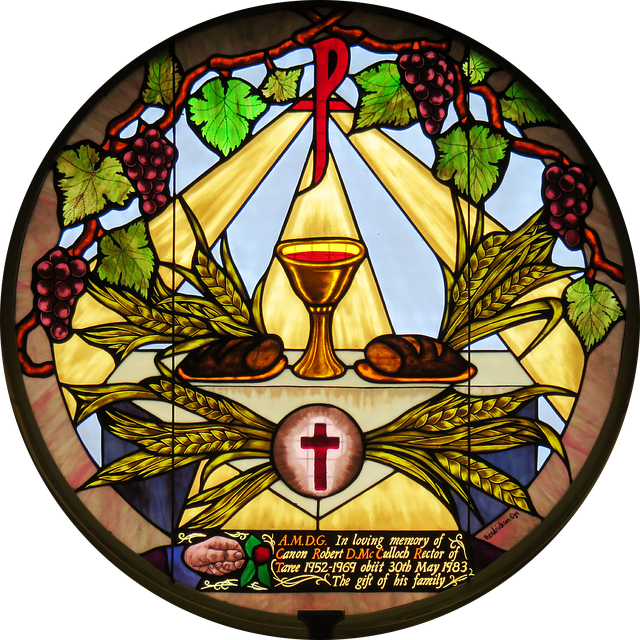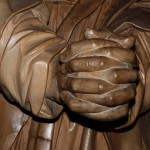Sermon Notes – Palm Sunday (Passion Sunday) – Year B
I would say that these notes will be shorter than normal because there are other services to prepare for this week, but I’m a bit verbose and hate cutting down on a word count. I apologize in advance if this takes a while to read!
Peace,
Porter
Liturgy of the Palms
Hosanna, hosanna. Hosanna in the highest. The Sanctus should be ringing in your ears as you listen to these lessons. The Lord has come to Jerusalem. His face has been turned toward the city like flint since coming down Mt. Tabor after the Transfiguration. The story has been moving toward this moment, yea this week, for months. The journey to Jerusalem is not the journey to the “hosannas” but to the cross. However, we cannot yet come to “crucify him!” without the triumph of, “Blessed is he who comes in the name of LORD.”
Either lesson can be used here: Jesus is yet again deconstructing our understanding of power; he is turning Roman imperialism on its head. Caesar, or any conquering general, would ride back into Rome on a chariot and/or warhorse as evidence of their successful military ventures—as proof that they had won. Often prisoners or war or foreign captives would be paraded as well. The people would cheer and the sing the praises of almighty Rome. Now, however, we have the one who is to be King (he already IS King!) entering not on a warhorse or chariot but on a donkey. What?
The crowds are absolutely correct with their sung praises of Jesus, even their ascription of a title, but their image of a King is way off. Jesus is indeed the One who is coming in the name of the Lord. He is blessed! He is the King of Israel! Their words come from Psalm 118 and are full of the promise that God will radically reverse the reality of his people; that God will uphold his covenant-promise through his steadfast, covenant love (hesed). N. T. Wright is so good on this point: though back in her land Israel is still living in exile. Rome is the ruler of Jerusalem, the Temple is empty of the Presence, and God’s people are waiting. They are waiting for their King and they think he has entered, but…
But he is not a militaristic king nor he is about to overthrow the political regime of Rome. His Kingdom is different. His Reign is humble—all powerful, yes!—but humble and founded on love. Power is not to be lorded over the gentiles (), it is instead demonstrated through the willing and voluntary death of Christ, through his humble entry into the city that he will weep over, in the helpless babe and crucified One.
In fact, if you want a good resource for Passion Week and Eastertide then go out and purchase N. T. Wright’s How God Became King. This is one of my favorite books by Bishop Wright and it gives a wonderful overview of kingship throughout the Old Testament and culminating in the incarnation, ministry, crucifixion, resurrection and exaltation of the Faithful Israelite. Any good Kingdom Theology will have this book as a resource.
The last verse in John’s account is important. The mystery of Christ is maintained until after the resurrection. The disciples did not, no they could not, understand what was in front of them (Jesus) until after his death and resurrection.
Liturgy of the Passion
Having entered the city we now turn our attention to the events of the following days. The task of the preacher on this Sunday is great. Sure, the imagery and texts may be rich and the possibilities endless, but how do you possibly cover such a vast story in 20-25 minutes? This is the beauty of Palm Sunday…while the entire Passion narrative may be read; one does not have to cover such ground in the same message. The whole Passion narrative was included in the lectionary in order to combat low church attendance on Maundy Thursday and Good Friday (not to mention the other days of Holy Week). It would be extremely confusing for someone to arrive at church on Palm Sunday and hear about the Triumphal Entry only to return the following Sunday to hear about the Resurrection: what happens in between is extremely important and to see the story as a complete story rather than individual pericopes is important.
The Triumphal Entry is behind us and we are now able to turn our attention to more important matters. No, that would be to miss the point entirely! We need to drag the humble procession of Christ into this long narrative. To really dig into the meaning of these scenes we must juxtapose the image of the crowds crying “Hosanna” with that of Jesus standing before Pilate and the crowds chanting “crucify him!” I’m about to go from preaching to meddling very quickly. It is not enough to feel anger toward Judas or toward the disciples over even toward the fickle crowd. Actually, that’s letting everyone off the hook easy. No, the really work is to recognize that I (and therefore YOU) am the one shouting “Hosanna” one minute and “Crucify him!” the next.
Much of the “meat” of these lessons will be unpacked throughout the week. On Maundy Thursday you can really dig into the Passover meal that Jesus shared and transformed with his disciples, how he instituted the Eucharist with his words and actions. You can dig into the idea of taking him at his literal word when he says, “This is my body” and “this is my blood” or you can focus on the acts of taking, thanking, breaking and giving as acts that we should live out in our lives eucharistically (I will post on this soon).
On Good Friday you can really cover the nature and meaning of the Cross. You can get into Atonement theory to your heart’s content. You can draw parallels between Psalm 22 and the words of Jesus on the cross. You can look at the forgiveness Jesus bestows even while being murdered. You can show the picture of humiliation only to then show the picture of victory on Sunday.
All of this is good, it is very good in fact. But none of this is really the point of Palm Sunday. No, the point of Palm Sunday is to demonstrate-in my opinion—how quickly Palms can turn to Passion.
So who was it that was on the cross? Well, it was the Servant of Isaiah 50 who was a good teacher and yet became the victim of hatred. It was the one in Philippians 2 who emptied himself (kenosis) and took on the nature of a man, who was obedient unto death. It was the one who had a woman anoint his feet with expensive oil, who cleared the temple, who shared a meal with his disciples, and who willingly went to the cross. In short, is the was Suffering Son of Man; it was the King of Israel who had been cheered only to be jeered; it was Jesus of Nazareth who would prophetically become King of the Jews as a label of scorn. It was the turning upside down of power. It was the victory of love. It was God drinking the cup to the dregs. It was Jesus’ self-offering, his oblation as an act of worship.
The Orthodox have a beautiful line in the Divine Liturgy of St. John Chrysostom during the Eucharistic prayer. It reads: “On the night He was betrayed, or rather gave Himself up for the life of the world.” The oblation of our Lord was no accident, nor was it done against his will. Jesus’ self-emptying was purely voluntary—in fact it is the very picture of power, of being in control. Preach on that!
To me these lessons really hone in on what it means to have the mind of Christ, what it looks like to embrace true humility, and yet they also demonstrate that our hearts are fickle. We are the victors of Palm Sunday and Easter Sunday and we are also the crucifying crowd on Good Friday—I’d even suggest that we are the betrayer on Maundy Thursday but that would get me into trouble!
Try preaching from the Liturgy of the Palms and juxtapose the scenes of the crowd crying, “We have no King but Caesar…Crucify him!” It’ll be a tough pillow to swallow on such a High Sunday but I think it’s a good practice.
Leave people with hope. We hope in the cross because we worship the Triumphant and Risen Lord. We are looking at this story from the side of Christ’s glory and can allow ourselves entrance into his narrative but always with the end in mind.











